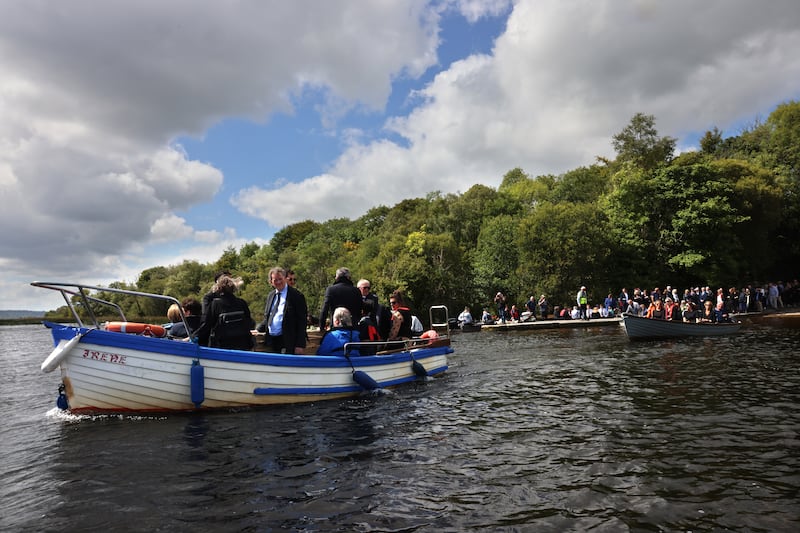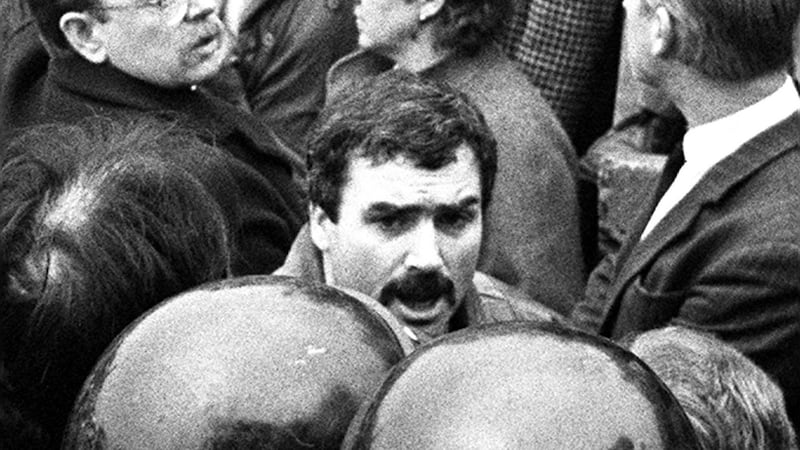In the final chapter, writer Edna O’Brien absolutely nails her ending.
If obsequies came with dust jackets, the back-cover blurb would call it a masterpiece.
We know she plotted the story from way out – the landscape, the characters, where she wanted to be buried and why, what sort of service, who should say the Mass, all the people she wanted to be there.
It was a perfect send-off for “brilliant, wild, soaring and indomitable Edna, who lived at the summit of her imagination.”
RM Block
Those words were spoken by her friend, the novelist Andrew O’Hagan, who read the eulogy.
For her last setting, the celebrated author came full circle and returned to where it all began – the small village of Tuamgraney in east Clare.
To the parish church where she was baptised and received the sacraments as a little girl and the home place she would leave as a young woman defiant in her refusal to bow to the suffocating demands of a patriarchal church.
Back then, over 60 years ago, clerics lined up to denounce her.
Today, in a changed Ireland with a largely different narrative, she is welcomed back.
And then some.
With three priests and a bishop above on the altar and the President of Ireland in the front row.
Not to mention the most important blessing of all – divine intervention.
“Didn’t she get a lovely day for it?” said everyone as Edna’s coffin was borne across the waves in glorious sunshine to her final resting place on Holy Island in Lough Derg.
Then men and women, working in relays, carried her up and over the brow of the hill down to the ancient graveyard with its ruined church and round tower to a plot beside her mother’s people.
There was, of course, a touch of drama with a hint of the turbulence of those earlier years from chief celebrant Fr Donagh O’Meara, hailing the celebrated author as “a speaker of the truth” who “held up a mirror for us in a very narrow time in Ireland”.
Fr O’Meara, who is Parish Priest in nearby Miltown Malbay, officiated at the funeral of Edna’s sister Eileen Blake six years ago and she asked him to say Mass for her when the time came.
On Saturday, the congregation in St Joseph’s church was probably wondering if any of the celebrants would mention the past, when several of Edna’s early books were banned for their scandalous references to sex and social issues.
But worse again – the unthinkable: they were written from the perspective of women.
Edna O’Brien brought their experience to the fore, said Fr O’Meara, chronicling “the hardships that women faced in a silent way” in Ireland at that time.
But she paid the price.

“We didn’t thank her for it. Like a lot of prophetesses of the past, we undermined her, we isolated her and rejected her message and she must have deeply felt that,” he said.
“Because when you stand out at any moment, at any time, you find yourself isolated quite quickly. And we did that. And that is to our shame as a society and as a church.
“That is to our shame.”
Strong words.
“Maybe she has discovered now, that in God’s eyes, she was infinitely loved.”
The congregation applauded.
“And with the Bishop of Killaloe and all sitting there on the altar beside him,” marvelled a woman in the churchyard afterwards, full of praise for the visiting PP. “You wouldn’t have heard that now a few years ago.”
There were readings by actor Stephen Rea and Edna’s son Carlo Gebler.
Her youngest son Marcus (Sasha) Gebler read a poem he wrote for his mother, “the original country girl”.
Then her nephew Michael Blake sang Danny Boy. There were more than a few sniffles in the pews.
But this was not a sad funeral. Edna died at the age of 93 after a full life well lived.
She was remembered as a “fabulous”, loving mother and a woman who was great fun on a night out.
“There would always be a glass of champagne, of course” said Andrew O’Hagan, recalling the time Edna turned to him, aghast, and declared, “Oh, Andrew, the great enemy is prosecco!”
The offertory gifts went some way towards illustrating this amazing life.

Grandson Oscar Gebler carried a box containing the glittering badge and star of a Dame of the British Empire, an honour to go with her French Legion of Honour and the golden torc of the Saoi, Aosdána’s highest honour.
Lyricist Sir Tim Rice brought up a photograph of Samuel Beckett and 007 movie producer Barbara Broccoli brought up an edition of Ulysses. There was a Buddha to signify Edna’s deep spirituality and a bunch of wild red roses from the garden of her family home down the road.
The tiny church – it doesn’t fit much more than 100 people – was perfumed by fresh flowers and incense. Extravagant bunches of huge red roses and white roses. A bouquet of stunning orchids with a card expressing condolences to the family and signed “Van”.
And a plump spray of green, white and orange roses and lilies.
“There is no end to grief, that’s how we knew there is no end to love” was the message on the card, signed “Bono and Ali”.
The flowers were arranged around the seagrass coffin on which was placed a family wreath, an open bible and a beautiful black and white photograph of Edna taken by Lord Snowdon.
On one side, high above her, a statue of the Sacred Heart and on the other, a statue of the Virgin Mary.
It was all there.
Then the church bell tolled and Marcus and grandchildren Jack, Finn and Euan Gebler shouldered the coffin outside to the hearse for the short journey to Knockaphort Pier and the boat to Inis Cealtra, the Holy Island.
The communities from Mountshannon, Tuamgraney and Scariff organised the flotilla of lake-boats to ferry the mourners to the island and helped with parking and traffic directing duties.
Local men volunteered to dig the grave.

It was all go on Saturday. And it wasn’t just Edna’s funeral. Apparently a nephew of JP McManus was getting married beyond in Adare Manor and it was a huge wedding. “Helicopters and everything.”
The boat left the pier at 2pm. Tuamgraney parish priest, Fr Kieran Blake waited to meet it on the shore at Holy Island. Adelheid Gowrie was one of Edna’s many friends from London who made the trip to say goodbye.
She got to know the author through her late husband, the Dublin-born peer Grey Gowrie – a poet and a former Conservative arts minister. The late Lord Gowrie and the author had a love of Ireland and literature in common.
“Edna was completely magical as well as being very beautiful,” Adelheid told us.
The coffin was carried up into the island, a few sheep watching on as the funeral procession passed.
At the graveside, musician Neil Martin played a haunting rendition of Cailín na Gruaige Doinne (The Girl of the Brown Hair) on the uilleann pipes.
A slow air on the summer air with the glistening lake stretching away to the Ogonelloe Hills and slowly ripening blackberries twining around the old stone wall sheltering the grave.
What a location. What a stunning backdrop. What a view.
Fr Blake said a decade of the rosary and then Mark Patrick Hederman, former abbot of Glenstal Abbey, and Nóirín Ní Riain sang Regina Caeli in Gregorian Chant.
Then the pipes.

Then the silence, save for birdsong and the distant sound of the waves.
If there can be such a thing as funeral envy, people were feeling it in that very moment.
Of course, it had to be Edna O’Brien’s funeral.
Back home, just as she wanted it.
That’s the way to craft an ending.
And as people waited to board their boats back to shore, they turned to each other and said: “Didn’t she get a great day for it?”
She did.
The best. That can’t all be down to luck.
- Sign up for push alerts and have the best news, analysis and comment delivered directly to your phone
- Join The Irish Times on WhatsApp and stay up to date
- Listen to our Inside Politics podcast for the best political chat and analysis

















